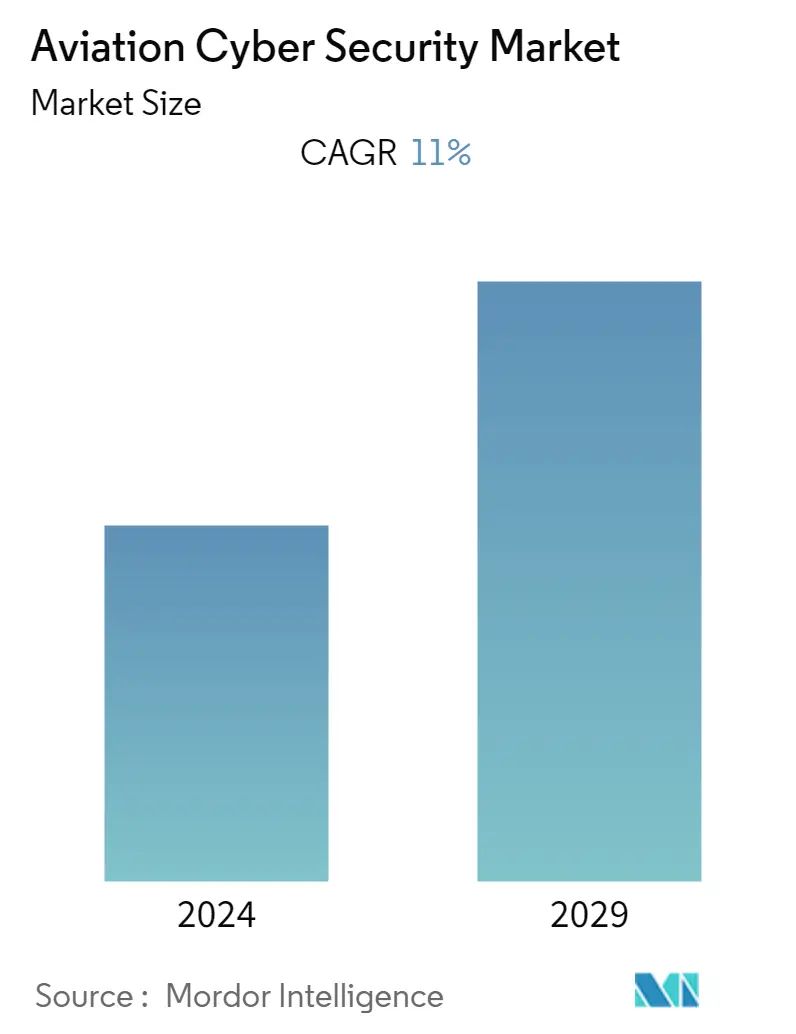Market Size of Aviation Cyber Security Industry

| Study Period | 2019 - 2029 |
| Base Year For Estimation | 2023 |
| CAGR | 11.00 % |
| Fastest Growing Market | Asia Pacific |
| Largest Market | North America |
| Market Concentration | Medium |
Major Players
*Disclaimer: Major Players sorted in no particular order |
Aviation Cyber Security Market Analysis
The aviation cyber security market is expected to register a CAGR of around 11%, during the forecast period, 2021-2026. The aviation sector has been benefitting from the increasing level of connectivity and digitization, across the value chain. The enabling technological advancements in the aviation sector are creating enormous opportunities to have better customer service, security, flight efficiency, operations, and passenger experience, both on the ground and in the air.
- With the advancement of technology and connectivity, the market has become prone and vulnerable to cyber attacks of malicious malware activities targeting the aviation sector. For instance, in December 2017, a major amount of sensitive security data was stolen at Perth Airport. The world's biggest airline, Cathay Pacific Airways Ltd., also suffered from a data breach, with the hacker accessing personal information of more than 9.4 million customers.
- Detection and prevention are the most sought-after solutions, as these threats are becoming more stealth with every attack. Owing to such instances, the corporates are trying to utilize the services of domain experts, thus, creating an opportunity for the market.
- A key driver for the market studied is the need for technological advancements to prevent the aviation sector, IT infrastructure, and networks from cyber attacks. Furthermore, as the aerospace sector moves toward the autonomy of spaceflight and is investing billions in developing aviation technologies, the need to protect the infrastructure becomes critical.
Aviation Cyber Security Industry Segmentation
The aviation industry relies heavily on IT infrastructure for its ground and flight operations. The security of these airline systems directly impacts the operational safety and efficiency of the industry and indirectly impacts the service, reputation, and financial health. The report highlights cyber security in the aviation sector by solution and application spanning from airline management, air cargo management, air traffic control management, and airport management.
| By Solution | |
| Threat Intelligence and Response | |
| Identity and Access Management | |
| Data Loss Prevention | |
| Security and Vulnerability Management | |
| Managed Security |
| By Application | |
| Airline Management | |
| Air Cargo Management | |
| Airport Management | |
| Air Traffic Control Management |
| Geography | |
| North America | |
| Europe | |
| Asia-Pacific | |
| Latin America | |
| Middle East & Africa |
Aviation Cyber Security Market Size Summary
The aviation cyber security market is experiencing significant growth, driven by the increasing connectivity and digitization within the aviation sector. This digital transformation has enhanced customer service, security, and operational efficiency, but it has also made the industry more susceptible to cyber threats. High-profile incidents, such as data breaches at Cathay Pacific and Perth Airport, underscore the urgent need for robust cyber security measures. As the sector moves towards greater autonomy and invests heavily in new technologies, protecting IT infrastructure and networks from cyber attacks becomes paramount. The demand for advanced detection and prevention solutions is rising, prompting companies to engage domain experts to bolster their cyber security frameworks.
The market is further propelled by the rapid increase in air travel, which necessitates upgrades in airport infrastructure and intelligence systems to enhance passenger experience and operational efficiency. The Asia-Pacific region, in particular, is witnessing a surge in demand for aviation cyber security, driven by ambitious growth plans and significant investments in airport development. In the United States, the aviation sector is aligning its cyber security programs with national standards, supported by substantial government funding for research and development. The competitive landscape is marked by high rivalry among key players like Cisco Systems Inc. and Thales Group, who are investing heavily in R&D and strategic acquisitions to enhance their offerings and expand their market presence.
Aviation Cyber Security Market Size - Table of Contents
-
1. MARKET DYNAMICS
-
1.1 Market Overview
-
1.2 Industry Attractiveness - Porter's Five Forces Analysis
-
1.2.1 Threat of New Entrants
-
1.2.2 Bargaining Power of Buyers/ Consumers
-
1.2.3 Bargaining Power of Suppliers
-
1.2.4 Threat of Substitute Products
-
1.2.5 Intensity of Competitive Rivalry
-
-
1.3 Introduction to Market Drivers and Restraints
-
1.4 Market Drivers
-
1.4.1 Increasing Rate of Cyber-attacks in the Aviation Sector
-
1.4.2 Technological Advancements and IT Systems Required to Support Passenger Traffic
-
-
1.5 Market Restraints
-
1.5.1 Lack of Cyber Security Professionals
-
-
1.6 Industry Value Chain Analysis
-
-
2. MARKET SEGMENTATION
-
2.1 By Solution
-
2.1.1 Threat Intelligence and Response
-
2.1.2 Identity and Access Management
-
2.1.3 Data Loss Prevention
-
2.1.4 Security and Vulnerability Management
-
2.1.5 Managed Security
-
-
2.2 By Application
-
2.2.1 Airline Management
-
2.2.2 Air Cargo Management
-
2.2.3 Airport Management
-
2.2.4 Air Traffic Control Management
-
-
2.3 Geography
-
2.3.1 North America
-
2.3.2 Europe
-
2.3.3 Asia-Pacific
-
2.3.4 Latin America
-
2.3.5 Middle East & Africa
-
-
Aviation Cyber Security Market Size FAQs
What is the current Aviation Cyber Security Market size?
The Aviation Cyber Security Market is projected to register a CAGR of 11% during the forecast period (2024-2029)
Who are the key players in Aviation Cyber Security Market?
Cisco Sytems Inc., Thales Group, The Raytheon Company, Lockheed Martin Corporation and Collins Aerospace are the major companies operating in the Aviation Cyber Security Market.

